Figure 2.

The effect of familiarity on the oculomotor rate modulation. Microsaccade (a) and Blink (b) rate modulation for the familiar (1, bold red) compared to every non-familiar face (2–8). Data were averaged per face across epochs within observer and then across observers. Time zero represents stimulus onset, with shaded orange areas illustrate the stimulus target and masks times, while the shaded gray area illustrates the time window (250–800 ms) used for subsequent RT analyses. For the Blink rates in (b), only epochs with a blink after stimulus onset were included (about 15%). Note the prolonged inhibition for the familiar face (red) for microsaccades as well as blinks. The gray bar indicates the significant cluster showing difference between the familiar face and the average of all other faces (nonparametric permutation test, see Methods), *p = 0.005 for microsaccades, and *p = 0.022 for blinks.
